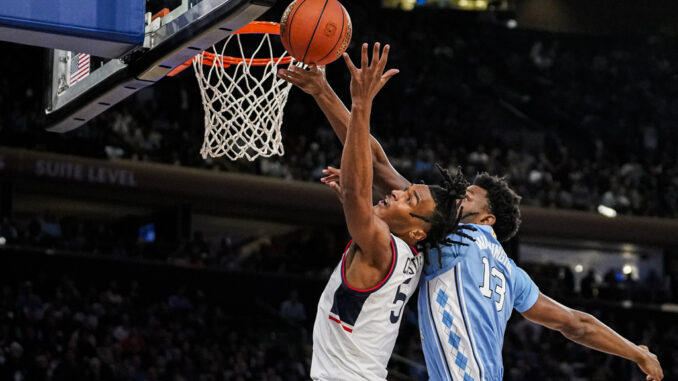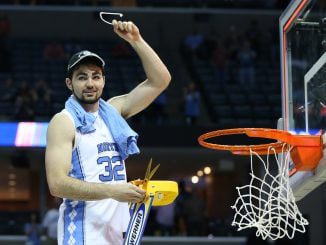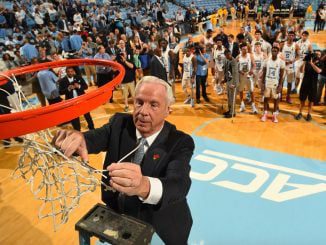
The Tar Heels could be excused for looking ahead to ACC play. That way, they’ll get an occasional break.
UNC is finishing up a brutal section of its early-season schedule. When the Heels play Kentucky in Atlanta on Saturday, it will be their sixth power conference opponent in a row with a seventh —Oklahoma in Charlotte — coming four days after that. The streak started with Villanova in the Bahamas, an overtime loss. They then beat Arkansas in a consolation game the next day. Back on the mainland, UNC hosted a top-10 opponent in Tennessee.
The only real break in the seven-game death march was the team’s ACC opener, against a Florida State team that has seen better days. Then it was right back at it with defending national champion UConn at Madison Square Garden. The Huskies handed the Tar Heels their second loss in the stretch.
That’s seven top-level opponents in five separate locations in a 28-day span.
UNC has always played high-profile games against big-name opponents during its nonconference schedule, and the Tar Heels have never been shy about traveling near and far to take on top competition. However, coach Hubert Davis appears to be pushing the envelope on the strength of schedule.
In Davis’ first season, the Heels played four power conference opponents — Purdue, Tennessee, Michigan and Kentucky. All were ranked at the time of the respective games. The following season, he added a fifth — Iowa State, Alabama, Indiana, Ohio State and Michigan. Three of them were ranked. This year, he’s up to six, and, unlike the previous two years, there are no App States of Citadels to help break up the run of power foes.
In fact, UNC now faces the fewest nonpower conference opponents of any ACC team. There are five on this year’s schedule, down one from last year. The Heels opened the season with Radford, Lehigh, UC Riverside and Northern Iowa, all at home, and they’ll have Charleston Southern at home between the Oklahoma game and the start of serious ACC play.
Georgia Tech (Georgia Southern, Howard, UMass-Lowell, Alabama A&M and UMass) is the only other ACC team to face just five. Wake Forest, Syracuse, Miami and Notre Dame have six on their schedule. NC State, Virginia and Pitt have seven. Duke, Clemson, FSU, Virginia Tech and Louisville have eight. Boston College has nine. Nationally, Purdue (Samford, Morehead State, Texas Southern, Jacksonville and Eastern Kentucky) can match the Heels for the smallest plate of cupcakes.
Will the aggressive scheduling accomplish what Davis is hoping? Will the Tar Heels enter ACC play battle toughened and ready for the nightly wars in the paint?
Davis has repeatedly questioned the team’s toughness and dedication over the previous two seasons, and results against the power conference teams have been mixed at best. The Tar Heels looked bad in losses to Purdue and Tennessee on successive days in November 2021 and later added a 29-point loss against Kentucky. Last year, Carolina dropped its first three high-profile nonconference showdowns. With two losses and two to play, the Heels could again be facing the prospect of three nonconference losses. Heading into Kentucky, they are 6-8 against elite conference teams in November and December the last three years.
The losses in previous seasons exposed problems that persisted throughout the year. In 2021-22, the Heels managed to make a postseason run that erased the season-long issues with toughness and teamwork, but those issues came back with a vengeance last year as Carolina missed the tournament.
This season, the problems seem less glaring, but there is still a pattern to the Villanova and UConn losses.
Against Nova, Armando Bacot struggled, finishing with just eight points and four fouls on 4-of-10 shooting, Against UConn, Bacot was 4 of 12, and Davis said afterward that the team needed to be better at rebounding. He praised both opponents for the ability to shut down Bacot in the post.
Both games also saw a more traditional Achilles’ heel for the Tar Heels resurface, as an obscure player came out of nowhere to light up the Heels. Forward Eric Dixon had a career day for Villanova, scoring 34 points with 10 rebounds, and against UConn, the Heels had no answer for the fiery Cam Spencer, who had 23 points.
Kentucky and Oklahoma are both more than capable of following the same game plan. The Wildcats have a 7-footer in their rotation in Aaron Bradshaw as well as 6-foot-9 senior Tre Mitchell, so they are more than capable of containing Bacot while a sharpshooter like freshman Reed Sheppard lights up the Heels from outside.
Oklahoma has a pair of 6-foot-10 regulars in John Hugley IV and Sam Godwin and ranks higher in offensive and defensive rebounding rates than the Tar Heels. Both teams are better inside shooting teams than Carolina, so UNC’s tough schedule may serve as a blueprint for future ACC foes on how to beat the Heels.
Adversity can build character and, in year three, this is the most high-character team Hubert Davis has had. Adversity can also expose weaknesses, however, and that can be deadly entering conference play.



